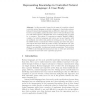Free Online Productivity Tools
i2Speak
i2Symbol
i2OCR
iTex2Img
iWeb2Print
iWeb2Shot
i2Type
iPdf2Split
iPdf2Merge
i2Bopomofo
i2Arabic
i2Style
i2Image
i2PDF
iLatex2Rtf
Sci2ools
KES
2004
Springer
2004
Springer
Representing Knowledge in Controlled Natural Language: A Case Study
In this case study I argue for the usage of a machine-oriented controlled natural language as interface language to knowledge systems. Instead of using formal languages that are difficult to learn and to remember for non-specialists, authors should be able to write specification texts in a well-defined subset of English that can be unambiguously processed by a computer. This subset of computer-processable English (PENG) consists of a restricted grammar and lexicon and is used together with an intelligent text editor that guides the writing process. The editor of the PENG system communicates with a language processor that generates logical structures while the author writes a specification text. The language processor is connected via a server with reasoning services that allow for acceptability checking and question answering. Texts written in PENG look seemingly informal and are easy to write and understand for humans but have first-order equivalent properties.
| Added | 02 Jul 2010 |
| Updated | 02 Jul 2010 |
| Type | Conference |
| Year | 2004 |
| Where | KES |
| Authors | Rolf Schwitter |
Comments (0)

